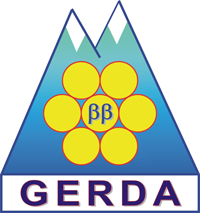The study of neutrinoless double beta decay is the most sensitive approach to answer the still unanswered question whether the neutrino is a Majorana particle like most extensions of the Standard Model assume. The potential of this method has increased considerably during the last years since a non-zero mass of the neutrinos has been established by the observation of neutrino flavor oscillations. In fact, the observation of neutrinoless double beta decay would not only establish the Majorana nature of the neutrino but also provide a measurement of its effective mass.
The most sensitive double beta experiments Heidelberg-Moscow and IGEX have used 76Ge as source and detector, and reach sensitivities around 0.3 eV in the effective neutrino mass. Both collaborations have reported almost the same upper limit on the lifetime of 1.6 ·1025 y, corresponding to a mass range of 0.33 to 1.3 eV. The group of Klapdor-Kleingrothaus (Heidelberg-Moscow experiment) claims a 4 sigma excess in the spectrum near the energy expected for neutrinoless double beta decay, and gives a neutrino mass range from 0.2 eV to 0.6 eV. Currently, no other experiment can either confirm or refute this observation.
Double beta decay experiments now taking data such as CUORICINO or NEMO may reach the 0.3 eV sensitivity region within a few years, using other nuclei as sources. These experiments have the potential to confirm the current positive evidence with similar significance, but they cannot refute it because of uncertainties in the ratio of nuclear matrix elements. It is clear that a 76Ge experiment capable of confirming the current result of the Heidelberg-Moscow experiment with high significance, or pushing the mass limits below the current, cosmologically still important 0.3 eV range is of high scientific relevance.
The GERDA proposal foresees the installation at LNGS of a facility where germanium detectors made out of isotopically enriched material will be operated inside a cryogenic fluid shield. The facility will be located in HAll A of LNGS and will serve a dual purpose. The setup will probe the neutrinoless double beta decay of 76Ge with a sensitivity of T1/2> 1026 y at 90% confidence level, corresponding to a range of effective neutrino mass < 0.09 - 0.20 eV within 3 years, thereby scrutinizing with high statistical significance the recent claim for evidence of neutrinoless double beta decay of 76Ge from the Heidelberg-Moscow experiment. Existing enriched germanium detectors from the previous Heidelberg-Moscow and IGEX experiments as well as a new set of detectors will be used. In addition the proposed experiment will be a pioneering low-level facility which will demonstrate the possibility of reducing backgrounds by 2-3 orders of magnitude below the current state-of-the-art. It will represent a major step on the way towards an ultimate double beta decay experiment aiming at a sensitivity in the 10 meV mass range.
The baseline option for the facility uses a 2m liquid nitrogen shield, contained in a vacuum-isolated copper cryostat, followed by about 3m of highly purified water. The nitrogen shields the low residual activity from the cryostat walls. The water complements the shield against rock and concrete. A cleanroom and sophisticated lock and suspension systems on top of the cryostat allow to insert and remove detectors without introducing contamination into the vessel. Gas purification and handling systems make extensive use of the experience accumulated in the BOREXINO experiment.
The experiment would proceed in several phases. The first phase encompasses the installation of the cryostat and shields, the installation and operation of conventional Ge detectors to determine the background rejection and to screen materials and identify backgrounds by classifying their spectra, and the operation of almost 20 kg of existing enriched 76Ge detectors, used in the past in the Heidelberg-Moscow and IGEX experiments. Within one year of measurement, the sensitivity of this setup should allow a statistically unambiguous statement concerning neutrinoless double beta decay with a lifetime around 1.2 · 1025 y. In parallel with the data taking of the first phase, techniques will by studied and implemented to provide improved enriched detectors to be used in a second phase. Particular emphasis is devoted to minimize cosmogenic activation of detectors by reducing the exposure and optionally moving production steps to underground facilities. Regardless of the outcome of the Phase I measurements, it is desirable to produce and operate a certain number of new detectors.
At the end of Phase II with 100 kg years, the sensitivity will be T1/2> 2 · 1026 years at 90% confidence level corresponding to a range of the effective neutrino mass <0.09-0.29 eV. The ultimate experiment capable to reach the 10 meV scale requires at least 0.5 t of enriched germanium and represents another huge step, which can only be afforded in the context of a world-wide collaboration.
